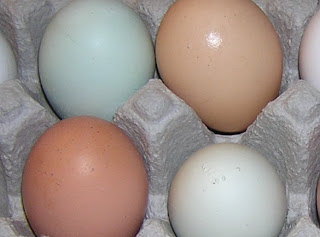Recipe UPDATED! I was making these cookies the other day and realized that a few things were off in the way I wrote it. Not a huge deal but I want to make it easy for everyone, even those who don't have enough experience cooking to interpret what I meant, rather than what I wrote.
This post is linked to the "Whole Foods for the Holidays Progressive Dinner" blog carnival, (dessert edition) hosted by Modern Alternative Momma. Visit for more real food desserts.
I also contributed this recipe to "Pennywise Platter Thursdays" on The Nourishing Gourmet.
This cookie is one of our favorites. I started with a Martha Stewart ginger cookie recipe and made some big changes - way less sugar (and whole sugar instead of brown), black strap instead of regular molasses, much more spice, chopped candied ginger, and whole wheat flour. As always I use free range eggs (my chickens) and Organic Valley butter (which the Cornucopia Institute says is pastured as advertised). Since it's made with nothing but whole food, have more than one!
This post is linked to the "Whole Foods for the Holidays Progressive Dinner" blog carnival, (dessert edition) hosted by Modern Alternative Momma. Visit for more real food desserts.
I also contributed this recipe to "Pennywise Platter Thursdays" on The Nourishing Gourmet.
 |
| Eggs from our hens. |
Very Gingery Cookies
375 degree oven. Makes about 12 (before dough is nibbled).
1 1/2 cups whole wheat flour (we use King Arthur White Whole Wheat... it might be too heavy if you used traditional whole wheat)
1 tsp. baking soda
1/4 tsp. baking powder
3 tsp. ginger
1/2 tsp. cinnamon
1/2 tsp. cloves
1/4 tsp. white pepper
1/4 tsp. salt
1/2 cup (1 stick) butter
1/4 cup rapadura
1/8 cup black strap molasses
1 egg
1 Tbl. vanilla paste (or extract) if you're using commercial stuff. 1/2 Tbl extra strength extract from your kitchen or mine.
1/4 - 1/2 cup candied ginger, chopped
Sift together dry ingredients. Cream butter, rapadura, and molasses. Beat in egg. Stir in vanilla. Add dry ingredients mixing until just combined. Stir in candied ginger. Roll into balls and place on buttered cookie sheet. Squish balls for a flatter cookie (if you like them that way). Bake at 375 for 12-14 minutes.
Devour.
P.S. These are super low sugar cookies. I've spent years gradually adding less and less sugar to my baked goods. I'm used to it and now I find that I'm not crazy about normally sweetened thing. However, this might be too much too soon. Feel free to add up to 3/4 cup sugar and 1/4 cup molasses as the original recipe calls for.











